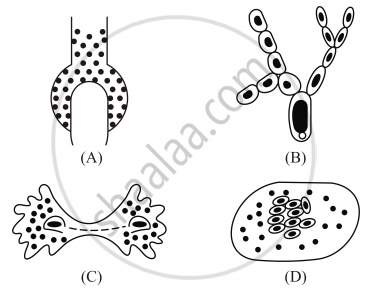Advertisements
Advertisements
Question
Name the mode of reproduction process seen in yeast.
Solution
Budding is the name of the mode of reproduction process seen in yeast.
APPEARS IN
RELATED QUESTIONS
Vegetative propagation takes place with the help of leaves in _________ plant.
List four modes of asexual reproduction.
How are the modes for reproduction different in unicellular and multicellular organisms?
How does Plasmodium reproduce. Is this method sexual or asexual?
Describe reproduction by spores in Rhizopus
Fill in the following blank with suitable word :
Vegetative reproduction of potato plants is done by using ............
How does binary fission differ from multiple fission?
Name one organism which reproduces by binary fission and another which reproduces by multiple fission.
State whether the above named organisms are animals or plants.
Name two organisms which reproduce by the same asexual process as that of Amoeba.
Name one unicellular organism which reproduces by the same asexual process as Hydra.
The unicellular organism which reproduces by budding is :
(a) Spirogyra
(b) Hydra
(c) Planaria
(d) Yeast
Asexual reproduction through budding takes place in :
(i) Amoeba and Yeast
(ii) Yeast and Hydra
(iii) Hydra and Plasmodium
(iv) Corals and Sponges
(a) (i) and (ii)
(b) only (ii)
(c) (i) and (iii)
(d) (ii) and (iv)
A feature of reproduction that is common to Amoeba, Yeast and Bacterium is that :
(a) they are all multicellular
(b) they are all unicellular
(c) they reproduce only sexually
(d) they reproduce asexually
The two types of organisms which produce colonies by the process of budding are :
(a)Hydra and Corals
(b) Yeast and Sponges
(c) Corals and Sponges
(d) Hydra and Yeast
The organisms which can reproduce by fragmentation are :
(a) Corals and Sponges
(b) Corals and Spirogyra
(c) sea anemone and Spirogyra
(d) Sponges and Sea anemones
A small part of the shoot of a plant is removed with a sharp knife. When the lower end of this small part of the shoot is buried in moist soil, it gradually develops roots and shoots and grows to become a new plant.
(a) What is the name of this method of propagating plants?
(b) What care should be taken while removing a small part of the shoot from the parent plant with a knife?
(c) Name any two plants which provide us with food directly or indirectly and are grown by this method.
(d) Give one advantage of this method of producing new plants.
(e) State whether it is a sexual method of reproduction or an asexual method. Why?
(f) What special name can be given to the genetically identical new plants produced by this technique?
Fill in the blank:
Budding produces cells of __________ size.
State whether the following statement IS true (T) or false (F):
Asexual reproduction is more common than the sexual reproduction.
State whether the following statement is true (T) or false (F):
A whole new plant can grow from the eye of a tuber.
Define the following:
Budding
Mention the common method of reproduction in Ferns.
Mention the common method of reproduction in Mango.
Mention the common method of reproduction in Bougainvillea.
What happens when on maturation sporangia burst?
Binary fission is observed in which one of the following figures?

In hydra the type of reproduction is ___________.
Explain the term Vegetative propagation.
Draw a labelled diagram in proper sequence to show budding in hydra.
Give the name of the plant that reproduces vegetatively by: Underground stem
Give the name of the plant that reproduces vegetatively by: Grafting
The form of vegetative reproduction of plants where seeds are formed without fusion of gametes is called
What is protandry?
Explain the development of male gametophyte in angiosperms (diagram is not expected).
Which of the following is not a type of asexual reproduction in multicellular organisms?
Name the three types of asexual reproduction in unicellular organisms.
A feature of reproduction that is common to Amoeba, Yeast, and Spirogyra is that ______
Vegetative propagation refers to formation of new plants from
The "Eyes" of the potato tuber are ______.
